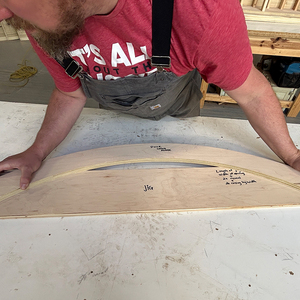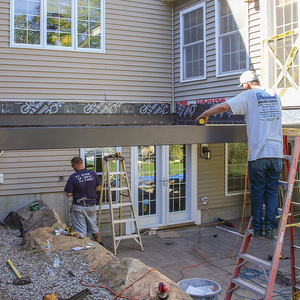How to add radiant to existing floors?
It’s chilly in the winter here in Oregon, where tiny tootsies turn blue on cold hardwood floors. Also, certain carpets frequented by — and shredded by — a former housecat develop an aroma when our house is closed for winter.
So, it’d be nice to pull out some carpet and add some radiant.
If you wanted to ditch the carpet, install a durable source of radiant heat, and recover the area with cork tiles, Marmoleum or even new carpet, how would you do it? What might you do about the fact that the living area would end up sitting higher than the surrounding hardwood?
Here’s the layout: Below our offending carpets lie plywood subfloors atop joists, under which we have a low basement. Batt insulation fills gaps between the joists.
In our family room, the carpeted sitting area is surrounded on two sides by hardwood expanses. The carpet is slightly “taller” than the hardwood, because the plywood subfloor it sits about 1/8 inch higher than the oaken floor.



















Replies
If the floor joists are accessible in the basement, I'd pull down the insulation and use the aluminum joist pans for the radiant heat. Replace the insulation. You won't disturb the floor above and you can make sure the insulation is done well.
Beat it to fit / Paint it to match
Thanks for that suggestion. I hadn't thought about aluminum joist pans. Now, I'm wondering what one would go about looping the radiant tubes around the joists, to hook all the radiant into one central site. Don't those tubes need to be encased in concrete or a rubbery matrix?
This is another alternative to the pans. They claim it is as effective in spreading the heat, plus it provides the insulation and vapor barrier. You don't need to do any encasing of the tubing with either the pans or this product. Only small holes are needed between joists for the tubing and a protective shield. This site has a lot of info on radiant heat systems, too.http://www.radiantdirect.com/components_insulation.phpBeat it to fit / Paint it to match
As long as we're looking at alternatives here, the OP should consider some of the pros and cons of naked tube in the joist space. This is a pretty good thread, from a very interesting forum:
http://forums.invision.net/Thread.cfm?CFApp=2&Thread_ID=39508&mc=39
This method is not nearly as good as an extruded aluminum plate in the joists. It is incredibly irresponsible of anyone to suggest that it is. not attacking you, of course.. just people who should know better.Compared to older, lightweight plates in joists you might be in the ballpark with reflective.. assuming it holds up over time, which I am skeptical of... but the new plates positively blow this method out of the water.Now, whether the parent NEEDS really good output or not depends on how chilly it gets in her area, and how well built her home is (read: depends on the results of a heat load calculation), and what she is trying to achieve. You can warm the floor without plates at all. If you are serving primary heat to a real load, then you probably want the plates. If this room is all she does, an electric mat above the subfloor may be the best choice if there is no existing hydronic system.-------------------------------------
-=Northeast Radiant Technology=-
Radiant Design, Consultation, Parts Supply
http://www.NRTradiant.com
As someone already mentioned, you can attach the radiant tubing up underneath the existing subfloor. Then put the insulation back in the cavities.
IMO, carpet above a radiant floor is a less effective because the carpet tends to insulate a bit... but it is still doable.
And of course radiant will work for tile, wood, vinyl, whatever.
jt8
"Success is not the key to happiness. Happiness is the key to success." --Albert Schweitzer
Would you say that the materials for such a retrofit are expensive? Or might the job be affordable, if my one, dear, true spouse did the work, assisted by his wifey?
Personally, I'd like to replace the carpet with Marmoleum, not only because it's beautiful but also because we eat in the family room all the time and need a moppable surface. (Thus, our family-room carpet is not only shredded and smelly but also stained. Very fine!)
Some acquaintances once put cork tiles over radiant heat, and the tiles came loose, because the glue melted. After they pulled up all the tiles and changed glues, though, the cork worked nicely.
Would you say that the materials for such a retrofit are expensive? Or might the job be affordable, if my one, dear, true spouse did the work, assisted by his wifey?
Well, there is a fair amount of materials involved. The PEX isn't too bad per ft, but you also have the metal plates, a manifold, some form of pump, and a boiler (or some form of water heater), and some other stuff, so by the time you're done you will have a fair amount of $$ involved. But then again, you're talking about really improving the quality of living in that house.
As far as the radiant floor, probably 90% of it can by DIY, since it is mostly just a matter of removing the insulation, attaching the tubing/plates to the underside of the floor (drilling through joists where necessary) and so on. Where you would either want to do a goodly amount of research or get professional help would be on the sizing of the unit, layout of the tubing, flow rates and the boiler hook-up.
Personally, I'd like to replace the carpet with Marmoleum, not only because it's beautiful but also because we eat in the family room all the time and need a moppable surface. (Thus, our family-room carpet is not only shredded and smelly but also stained. Very fine!)
If you know the manufacturer, you can contact them (and/or check their website) and see if they have any comment of use over radiant flooring. Isn't Marmoleum kind of like spongy-vinyl? I've never tried installing it, so don't know anything about it. Someone else might pipe up with more info.
jt8
"Success is not the key to happiness. Happiness is the key to success." --Albert Schweitzer
There are a lot of systems for radiant heat out there. What I would is get their info. and then decide what one you want to go with. Most will answer all of your questions and a lot of them will give you free design specs. Lots of luck. -------------------------------------------------------------------